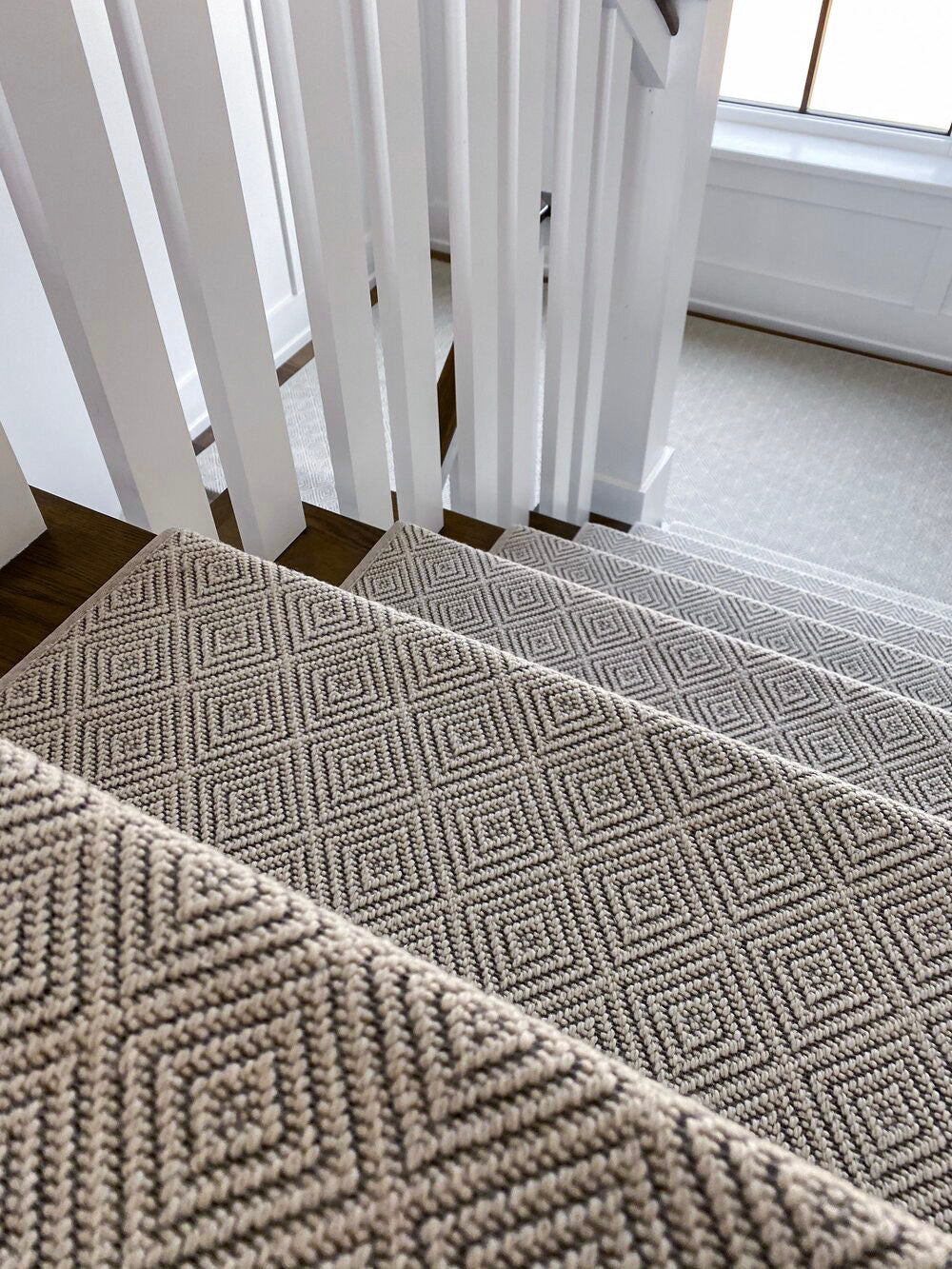If your stairs feel too narrow, too steep, or just a little off—there’s a good chance tread size is the problem.
So, what is the standard size for stair treads?
Most stair treads in residential homes are 10 to 11 inches deep and 36 to 42 inches wide, offering safe, comfortable space for daily use (International Residential Code, Section R311.7.5.2).
Most stair treads in residential homes are 10 to 11 inches deep and 36 to 42 inches wide, offering safe, comfortable space for daily use
In this guide, we’ll walk you through how to measure, when to go custom, and how carpet stair treads can transform both the safety and look of your staircase.
Why Stair Tread Size Matters
Choosing the right stair tread size isn’t just about appearance—it directly affects how safe and functional your stairs are.
Treads that are too short or narrow can increase the chance of slips and missteps, especially for children, pets, or seniors.
On the other hand, if treads are too wide, they can disrupt the natural stride, cause awkward foot placement, and potentially make climbing the stairs feel less stable and intuitive.
Accurate sizing ensures proper foot placement, improves grip, and gives each step a more secure feel underfoot.
It also makes your stair upgrade look like a professional installation—even if it’s DIY.
What Is the Standard Size for Stair Treads in Homes?
In most U.S. homes, the standard size for stair treads is:
-
10 to 11 inches deep (measuring from front to back)
-
36 to 42 inches wide (side to side)
These dimensions align with building codes and work well with the average adult stride (International Residential Code, Section R311.7.5.2).
They provide enough space for safe walking, reduce fall risks, and offer a balanced, visually pleasing look on most staircases.
When using carpet stair treads, this standard size also gives you plenty of coverage without interfering with the stair’s structure or design.
How to Measure Your Stairs Accurately
Measuring your stairs correctly is the first step to getting treads that fit and perform well.
Here’s how to do it:
1. Measure the Depth Place your tape measure at the front edge of one stair and extend it to the back edge. Don’t include the overhang (nosing).
2. Measure the Width Measure across the full step—wall to wall if enclosed, or edge to edge if open.
3. Check for Inconsistencies Take measurements on multiple steps—top, middle, and bottom—to make sure dimensions don’t vary slightly.
This is especially important if your staircase includes curves, split levels, or tapers.
That’s when unique stair treads shapes may be necessary.
What If My Stairs Don’t Match the Standard Size?
If your stairs don’t match the standard 10–11 inch depth and 36–42 inch width, don’t worry—you can still achieve a safe, stylish result.
Custom stair treads can be made to fit any size or shape, whether your steps are narrower, wider, deeper, or uniquely angled.
When standard options won’t work, custom solutions like unique stair tread shapes provide a precise fit that enhances both safety and design.
Accurate measurements are key—measure each step’s depth and width, including any curves or tapers.
A trusted provider can create made-to-measure treads that align perfectly with your stairs, avoiding shifting or gaps.
With the right support and materials, even non-standard staircases can be upgraded for both function and beauty.
Why Shape Matters When Choosing Treads
While many stairs can use standard rectangular treads, the shape of your staircase may call for something more tailored.
For example:
-
Spiral staircases often need treads that taper at one end. Spiral staircases have a curved design where the inner edge of each step is much narrower than the outer edge, so treads must be cut to taper inward to fit the curve smoothly and provide safe footing.
-
Rounded steps require crescent or arc-shaped cuts. Rounded or bullnose steps curve outward at the edge, which means treads must follow that curve with crescent-shaped cuts to align with the contour and ensure full coverage and stability.
-
Open-riser stairs may need a modified backing or contour. Open-riser stairs, which don’t have a vertical backing, may require treads with added support or a modified contour to stay secure and stable, since they lack the natural “back wall” for support.
These are all examples of unique stair treads shapes—designed to blend seamlessly with your stairs rather than sit awkwardly on top.
Choosing the right shape ensures your stair treads stay in place, look polished, and offer full surface coverage.
Benefits of Rectangular Carpet Stair Treads
If your stairs are straight and standard-sized, rectangular carpet stair treads are often the easiest and most effective option.
They’re:
-
Easy to install (especially with peel-and-stick backing)
-
Available in a wide variety of colors, materials, and pile types
-
Designed to cover the highest-traffic area of each step
These treads reduce noise, prevent slipping, and protect your hardwood or painted stairs from wear—making them a favorite for families with pets and kids.
Plus, the clean rectangular shape provides a crisp, uniform look that feels upscale yet effortless.
Stair Tread Size in Commercial Spaces
In commercial buildings, stair treads are generally larger to accommodate increased foot traffic and ensure accessibility.
Here’s what you’ll commonly find:
-
Widths of 44 inches or more
-
Depths between 11 and 13 inches, depending on local codes
These dimensions support people using mobility aids or walking in groups and are built to last under high traffic.
For homes that include business spaces—like salons, boutiques, or rental units—commercial sizes might be more appropriate.
Do Carpet Stair Treads Come in Standard Sizes?
Yes, many carpet stair treads are pre-cut to fit standard 10” x 36” or 10” x 42” sizes.
These are ideal for quick DIY projects and work perfectly with most residential stairs.
But if your stairs are smaller, larger, or curved, you’ll want to consider custom options.
Custom sizing ensures the treads stay flush, secure, and properly centered on each step—especially important when kids or pets are running up and down.
Don't Forget the Stair Landing
Once your steps are covered, think about the top or bottom of your staircase.
Adding a carpet stair landing at these points:
-
Creates visual cohesion from top to bottom
-
Offers a soft place to land
-
Adds another layer of safety and comfort
It’s one of the easiest ways to give your staircase a finished, professionally styled appearance.
Steps To Success
So, what is the standard size for stair treads?
The answer is 10 to 11 inches deep by 36 to 42 inches wide—but the best fit depends on your specific staircase.
To find your perfect size, here’s what to do:
-
Measure each step carefully (both depth and width).
-
Decide between standard or custom sizes.
-
Choose rectangular carpet stair treads for straight stairs or go custom for unique stair treads shapes.
-
Add a carpet stair landing for a polished finish.
-
Select a style and color that fits your home’s design.
At Oak Valley Designs, we make it easy to create stairs that are safe, beautiful, and built for daily life.
From free swatches to made-to-order options, our products are designed with families, pets, and comfort in mind.
Let’s Help You Find the Right Fit
Whether you’re measuring your stairs for the first time or finally ready to replace those slippery wood steps, we’re here to guide you.
Choose from standard options or request a custom size that fits your home perfectly.
-
Website: https://oakvalleydesigns.com/
-
Phone: 706.331.0315
-
Email: info@oakvalleydesigns.com
-
Address: 30 River Ct SW Bldg E Cartersville, Ga 30120




